Kostenloser Versand ab 35€ Bestellwert!
-
Shop
- Insights
-
Über ROMBO
- Händler
- Plektren-Finder
- Geschenkgutschein
+Kategorien
- accessories
- bass
- bass pick
- bass picks
- bass plectrum
- bass plectrums
- beginner
- bright tone
- chose guitar pick
- chose guitar picks
- chose plectrum
- chose plectrums
- CrystalBright
- Diamond
- Diamond pick
- discipline and guitar
- DIY generation
- durability pick
- durable pick
- eco
- ecoblack
- find guitar pick
- find plectrum
- fingers vs picks
- grip
- grip guitar pick
- guitar accessories
- guitar advantages
- guitar benefits
- guitar career
- guitar health
- guitar injury
- guitar learn
- guitar lesions
- guitar lesson
- guitar method
- guitar noise
- Guitar noise plectrum
- guitar pain
- guitar pick
- guitar pick beginner
- guitar pick bevel
- guitar pick buy
- Guitar pick diamond
- guitar pick durability
- guitar pick durable
- guitar pick eco
- guitar pick features
- guitar pick grip
- guitar pick material
- Guitar Pick Noise
- Guitar Pick online
- guitar pick recycled
- guitar pick recycled material
- guitar pick special features
- guitar pick textures
- guitar pick thickness
- guitar pick variable thickness
- guitar picks
- guitar tone
- guitar warm-up
- guitarpick
- guitarpicks
- hold a guitar pick
- hold guitar pick
- hold guitar picks
- hold pick
- hold plectrum
- hold plectrums
- how to
- how to chose your guitar picks
- jazziii
- learn guitar
- lose guitar pick
- material
- materials
- mental health and guitar
- motivation and guitar
- music
- not to lose guitar pick
- Online guitar
- online guitar pick
- online guitar pick buy
- pick
- pick durability
- pick material
- pick noise
- Picks
- picks vs. fingers
- play bass fingers
- play bass picks
- play bass with fingers
- play bass with pick
- play bass with picks
- play bass with plectrum
- play guitar faster
- plectrum
- plectrum attributes
- plectrum beginner
- plectrum bevel
- plectrum characteristics
- plectrum features
- plectrum grip
- plectrum material
- plectrum noise
- plectrum recycled
- plectrum shape
- plectrum variable thickness
- plectrums
- Plek
- pua
- recycled
- recycled guita pick material
- recycled guitar picks
- recycled picks
- recycled plectrum
- Rombo Diamond
- rombopicks
- tendonitis guitar
- the guitar pick
- tone
- variable thickness
- warm tone
- warm-up guitar

Guitar Pick Deep Analysis: Rombo Diamond
Guitar picks can be found in all shapes, colors, and materials. These small items used for specific guitar techniques can offer different tones, dynamic ranges, and ergonomics, and therefore create a totally different playing experience depending on the pick you use.
The aim of this series of articles is to inform you in detail in a way that you wouldn’t find anywhere else. We want you to understand why we do what we do. So relax, hold your tea, and enjoy our first deep analysis on the guitar pick Rombo Diamond.
1 - Guitar pick Rombo Diamond: Overview

Exceptional picking control and accuracy. Favorite amongst advanced guitarists. The hole in the middle provides extra control and grip rate. Sharp tip for high attack, and clean bright tones.
2 - Guitar Pick Geometry Analysis
Guitar pick size
With its 28,4 x 25,5 mm, Rombo diamond can be considered a small-medium sized guitar pick.
Small guitar picks have several advantages: They perform exceptionally when practicing speed and are perfect for shred techniques.
With small-sized plectrums, your fingers are closer to the strings and you get more feedback from your guitar playing.
The downside of these picks is that they can be dropped easily. This is the reason we decided to increase the size of Rombo Diamond a little bit and make it small-medium. The first prototype was only 25 mm high.

Furthermore, we decided to increase the width to match the regular size of a thumb.
Guitar pick shape
The shape of a guitar pick is often overlooked. However, in the case of Rombo Diamond, thanks to its form and the pointy guitar pick tip, the attack and the control are substantially increased.
The pointy guitar pick tip, with only 3 mm in diameter, was designed to provide maximum note control.



The angle of the tip is wide enough to let your guitar strings slide longer.
Rombo Diamond has a slight bevel edge, mainly used to increase the guitar playing speed.
With a rounded bevel like this, the attack of the guitar pick gets smoother, a feature that changes the feedback you receive when you use specific techniques.
This is only possible for guitar picks with enough thickness, and it is very popular because of the feeling of easiness it provides while playing guitar.
Guitar pick thickness and guitar pick flexibility
The guitar pick thickness mainly defines how flexible a guitar pick is. However, other aspects like tone and ergonomics are mostly influenced by the thickness of the pick.
Rombo Diamond has guitar pick variable thickness along its body. This means that this guitar pick has different thicknesses for the hold area and for the tip area.

The thickness of the tip is 1,35 mm, providing enough space for the bevel edge mentioned before. This can be considered as a heavy/thick guitar pick.
The thickness of the hold area varies due to the diamond design. At the highest point, right in the middle where all the vertices create the diamond design, it is 2,65 mm thick.
The variable thickness on Rombo Diamond has been implemented primarily for two reasons:
It increases the feeling of control because the pick is easier to hold
It increases the bass tones, creating a much thicker tone
Both dimensions create a very rigid guitar pick.
The thickness of a guitar pick is also an essential factor in terms of durability. The shape and bevel combined with the polished tip and its thickness make this pick very durable.
3 - Guitar pick Materials and Surfaces
Guitar pick material
The material of a guitar pick is strictly connected to its flexibility and tone.
Rombo Diamond is offered in the Rombo polymer and the EcoBlack polymer, which offer the same characteristics.
The polymer we use is an improved variation of nylon designed to increase the durability and cause some tone changes. It is manufactured in Italy.

Since we use the same material for all our guitar picks, this part of the analysis will be skipped. We have already created an extended article regarding the materials that can be found here.
Guitar pick design
The Guitar Pick design is obviously inspired by a diamond shaped geometry. Rombo Diamond was meant to be hard, durable and rigid, therefore this design matches its mechanical attributes very well.
The functional surfaces were distributed in a way to enhance the diamond form. The grip area in the middle makes the diamond visible, while the polished areas give the shape and tip more optical clarity.

As we will see in the next chapter, the 3D surfaces were designed as functional surfaces to improve the grip. However, with the first prototypes, we realized that this was a very nice way to explore more design nuances.
Guitar pick grip
For the grip of Rombo Diamond, there are three aspects to consider:
The material
The 3D Geometry The micro-nodules texture
The micronodules texture is the texture we developed to create a comfortable grip. Usually, this texture wouldn’t be enough for a good grip and for this reason, we incremented the grip using the right material and 3D surfaces.
The 3D surfaces with the shape of a diamond have different thicknesses and tilted angles that fold the surface in different directions. This increases the grip substantially and avoids the rotation of the pick while playing.
For the people who like to hold the pick on the back side, we created a tunnel to compensate for the thickness reduction this area has.

We consider Rombo Diamond to be a pick with medium grip.
Guitar pick colors
Currently Rombo Diamond is offered in the following colors.

Manufacturing technique
Rombo Diamond is manufactured using an engineering technology called injection molding, in which melted polymers are forced to fill a mold and get a specific shape.
After that, there is a small mark called “the gate” in the back of the pick, which is where the melted material flows through to enter the mould. After the production, this manufacturing mark is treated by hand to make it smaller and less visible.
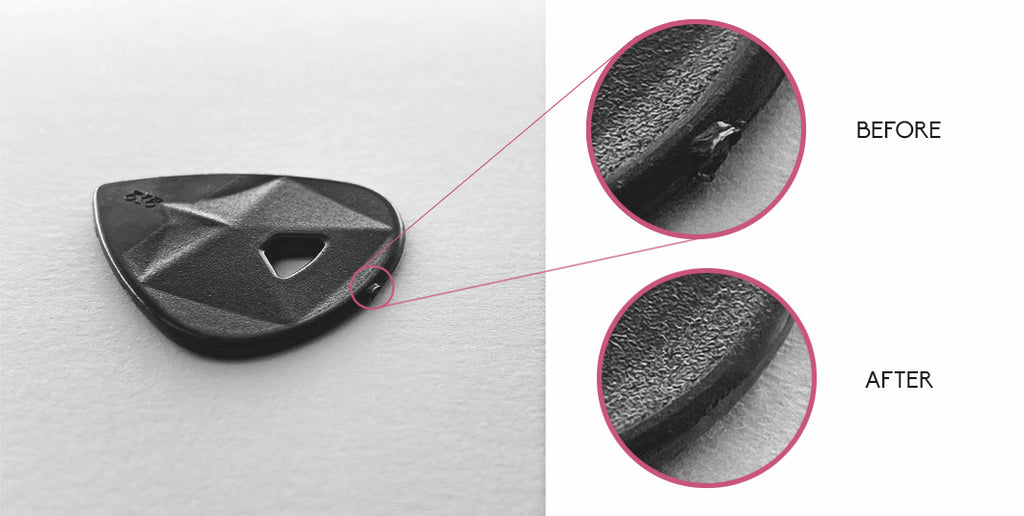
The borders of the pick have a parting line which is also removed post-production to increase the quality of the borders of the guitar pick.

Rombo Diamond is manufactured by automatic processes. However, a post treatment by hand is necessary to achieve the quality Rombo pursues.
4 - Guitar pick sound
Guitar Pick tone
So far, we have defined Rombo Diamond as a very thick, small-medium guitar pick, with a sharp tip. These are the typical characteristics of a pick that produces very bright tones.
However, due to the variable thickness mentioned before, we incremented the dynamic range of the guitar pick, allowing the player to enjoy some bass dark tones as well.
Usually, guitar picks with a very heavy attack can reduce the sustain of your guitar tone. With these small thickness changes we solved this problem.
The polished guitar pick tip, combined with its shape, enhances the bright tones and allows you to play some of the harmonic techniques on an electric guitar more easily.
The bevel edge can create those beautiful thick and compressed tones that we all like for distortion and overdrive.
Rombo Diamond is a pick that produces bright and clear tones, but with slightly dark shades in the background, which makes the sound richer and more complete.
Guitar Pick Noise
Because of the integrated bevel edge, the material toughness, the shape, the pointy polished tip, and the thickness, we consider Rombo Diamond to be a guitar pick that creates lower pick noise.

5 - Guitar pick techniques
Rombo Diamond was designed for the advanced player who likes speed, volume, attack, and control, but still wants a sophisticated tone and more than just power.
It is mainly intended for electric guitars.
Arpeggios and shred techniques like sweep, alternate, and tremolo picking are good examples of techniques which can be improved using the right guitar picks.
For strumming and palm mute, using Rombo Diamond can give you a much thicker and complete sound creating a bigger atmosphere when playing guitar.
6 - Pricing
Rombo Diamond is currently offered only in guitar pick sets containing four guitar picks in different color combinations and a packaging card with extra information about the pick attributes.
This pick is also included in the Variety Pack from Rombo, with other guitar pick models.
7 - Conclusion
Size: Small-Medium
Shape: Pointy tip, sharp attack angle
Thickness: Heavy with variable thickness. Hold area: 2,65 mm - Attack area: 1,35 mm
Materials: Rombo Polymer and EcoBlack
Durability: Very high
Design: Diamond Design with two different surface types.
Grip: Medium, micro-nodules combined with 3D Surfaces
Colors available: Graphite Black, Water Blue, Strawberry Red, Honey Yellow, EcoBlack
Manufacturing technique: Injection moulding and hand processing of the borders.
Tone: Bright, clear tones with a bass nuance on the background caused by the geometry.
Pick noise: Low
Techniques: Mostly electric guitar. Lead guitar techniques and high volume distortion.
Pricing: Guitar Pick Set Rombo Diamond

7 Wege, um Plektrumgeräusche zu vermeiden
Plektrumgeräusche lassen sich nicht ganz vermeiden. Insbesondere bei der Aufnahme von Akustikgitarren neigen Plektren dazu, viele Klick- und Klackgeräusche und Geräusche zu erzeugen, die dein Spielerlebnis sowie das deiner Zuhörer ruinieren kann.
Beim Gitarre lernen, wirst du einen Punkt erreichen, an dem du dich auf die Übertragung von Emotionen, das wirkungsvolle Spielen und eine bessere dynamische Kontrolle konzentrieren möchtest.
Um Gitarrentechniken zu meistern, musst du jeden Ton, der von der Gitarre erzeugt wird, vollständig kontrollieren: beabsichtigte und unbeabsichtigte.

Ich persönlich denke, dass Plektrumgeräusche ein Teil des Gitarrenspiels sind, und ich genieße sogar einige Vintage-Aufnahmen, bei denen das Plektrumgeräusch fast absichtlich vorhanden zu sein scheint. In den meisten Fällen möchtest du es jedoch beseitigen.
Wir haben alle Tipps und Tricks zusammengefasst, von denen wir glauben, dass sie dir helfen können, die Geräusche beim Spielen mit einem Plektrum zu reduzieren.
1- Halte das Plektrum mit weniger Spannung
Gitarrenpicks erzeugen beim Zupfen/Anschlagen der Saiten Geräusche. Wenn du dein Plektrum lockerer hältst, hilft das sehr, da deine Finger einen Teil der Energie absorbieren, wenn das Plektrum auf die Saiten trifft.
Wir haben einen Artikel mit dem Titel „Wie man ein Gitarrenplektrum hält“ veröffentlicht, der alles enthält, was du wissen musst, um diesen Trick zu meistern.

Beim Aufnehmen kann es hilfreich sein, dein Instrument im Verhältnis zu den anderen etwas lauter zu machen. Dies ist eine in Studios übliche Methode, die den Gitarristen hilft, sich zu entspannen.
Egal, ob du eine Studio-Session, einen Jam mit deinen Freunden oder einige Solo-Relax-Sessions zu Hause planen, ein bewusstes Aufwärmen vor dem Gitarre spielen ist Pflichtprogramm.

2- Probieren verschiedene Winkel beim Anschlagen aus
Der Winkel des Plektrums im Verhältnis zu den Saiten ist das am meisten diskutierte Element, wenn es um Plektrumgeräusche geht.
Grundsätzlich gilt: Je weniger Plektrum mit den Gitarrensaiten in Kontakt kommt, desto weniger Lärm erzeugt es. Deshalb winkle das Plektrum leicht zu den Saiten an.
Probiere verschiedene Winkel beim Anschlagen und Zupfen aus. Dies erfordert eine bewusste Anpassung deinerseits, aber sobald du es gemeistert hast, kannst du den Anschlag des Picks leichter variieren.
Abhängig vom verwendeten Plektrum, dem Musikstil und den Gitarrentechniken, die du verwendest, und deinem Können, benötigst du einen anderen Anschlagwinkel. Konzentriere dich also 30 Minuten darauf, den besten für dich zu finden, und gewöhne dich daran, diesen zu spielen.
3- Ist deine Schlagkraft passend?
Manchmal spielt man und der Flow setzt ein, man verlässt gedanklich den Raum und betritt „die Zone“, diesen schönen Ort, an dem man besser klingt als sonst.
Wir gehen so sehr in die Musik hinein, dass wir natürlich härter zuschlagen.

Übermäßige Anschlagkraft ist eine der häufigsten Ursachen für Plektrumgeräusche. Darüber hinaus kann es das Sustain abwürgen und dazu führen, dass die von dir gespielten Noten auf viel weniger natürliche Weise ausklingen.
4- Nylon-Gitarrenpicks sind weniger laut
Das Material der Gitarren-Plektren beeinflusst nicht nur den Ton, sondern auch das Geräusch, das das Plektrum erzeugt.
Nylon gilt als eine der am wenigsten lauten Formeln, wenn es um industrielle Materialien geht, die für Gitarrenpicks verwendet werden.
Dies liegt an der Zähigkeit dieser Mischung, die dank ihrer mechanischen Eigenschaften starke Stöße effizient absorbieren kann.

Bei Rombo verwenden wir eine modifizierte Version von Nylon, die für zusätzliche Haltbarkeit sorgt und die Lebensdauer der Plektren verlängert. Dies war notwendig, da Gitarrenpicks aus Nylon sehr schnell verschleißen. Hier erfährst du mehr über die Materialien.
Wenn du dir nicht sicher bist, ob du das richtige Plektrum verwenden, ist ein Variety-Paket eine gute Option, das Gitarrenpicks mit unterschiedlichen Attributen enthält. Dies ist eine gute Möglichkeit, mehrere Picks zu testen und deine Entwicklung zu verfolgen, während du beginnst, deine Fähigkeiten für jedes einzelne Plektrum zu verbessern.
5- Die richtige Dicke des Plektrums
Als Faustregel kann man sagen, dass schwerere Plektren weniger laut sind, was irgendwie widersprüchlich klingt. Aber warum ist das so?

Die Verwendung sehr dünner Plektren in Kombination mit schnellem Spiel, wie Strumming, führt dazu, dass sich die Plektren verbiegen, wenn sie die Gitarrensaiten verlassen, wodurch eine Art Klickgeräusch entsteht. Dies geschieht besonders beim Spielen von Akustikgitarren, da der Korpus der Gitarre als Verstärker für diesen Klang fungiert.
Schwerere Plektren lassen jede Saite ihren eigenen Ton ohne viele Begleitgeräusche erzeugen.

Die variable Dicke, die in allen unseren Gitarrenplektren enthalten ist, verbessert nicht nur die Kontrolle, sondern reduziert auch das Rauschen. Der Körper des Plektrums ist dicker und steifer, während die Spitze dünner und flexibler ist. Mit diesem Merkmal wird die Gesamtflexibilität der Spitze verringert, während ihre ursprüngliche Dicke und ihr ursprüngliches Material beibehalten werden. Das bedeutet mehr Kontrolle und weniger Lärm.
Dicke vs. dünne Plektren. In diesem Artikel besprechen wir alle Aspekte, die einen Unterschied machen.
6- Eine abgeschrägte Kante kann helfen, das Pickgeräusch zu reduzieren
Plektren mit einer abgeschrägten Kante gleiten besser und verursachen weniger Geräusche. In Kombination mit dem bereits erwähnten Anschlagwinkel können sie dir dabei helfen, das Plektrumgeräusch stark zu reduzieren.
Auch die Form und Größe des Plektrums sind wichtig, aber das ist eher eine Frage der Präferenz.

7- Reduziere Plektrumgeräusche mit einem Plektrum mit polierter Spitze
Wir haben häufig darüber gesprochen, welchen Einfluss eine polierte Spitze auf den Ton und die Haltbarkeit eines Gitarrenpickels hat.
Eine polierte Spitze gleitet auch ganz leicht über den Rand der Gitarrensaite. Auf der anderen Seite erzeugen Gitarrenplektren mit einer raueren Textur an der Spitze eine stärkere Höhenwiedergabe, selbst wenn sie am Rand gespielt werden. Dies passiert auch, wenn die Picks beginnen, sich abzunutzen.

Einige puristische Gitarristen bevorzugen jedoch, wie am Anfang des Artikels erwähnt, das Plektrum sogar, um Geräusche zu erzeugen, und haben es extra in ihre Aufnahmen eingebaut.
Bonus: Nimm dich sich selbst auf
Sehr erfahrene Live-Spieler, die nicht viel Studioerfahrung haben, reflektieren manchmal nicht genug über all die kleinen Nuancen ihres Spiels.

Eine gute Übung, um dies zu vermeiden, ist sich selbst aufzunehmen. Es ist erstaunlich, wie viel wir verpassen, wenn wir in die Zone kommen. Du wirst beim Anhören deiner Tracks Plektrengeräusche bemerken und es ist viel einfacher, kritische Bereiche zu identifizieren, als während des Spielens.
Wenn du Akustikgitarre spielst, versuche, das/die Mikrofon(e) an verschiedenen Orten zu platzieren, du wirst feststellen, wie viel Unterschied es in Bezug auf das Plektrumgeräusch machen kann.
Abschluss
Wir können Plektrengeräusche nicht vollständig eliminieren, aber es gibt genug zu tun, um unser Spiel zu verbessern und es erheblich zu reduzieren.
Der beste Weg, Plektrumgeräusche zu reduzieren, besteht darin, sich dessen bewusst zu sein und über dein Spiel nachzudenken, um deine Fähigkeiten zu verbessern und verschiedene Plektren für verschiedene Stile und Gitarrentypen auszuprobieren.
Wenn du eine neue Möglichkeit entdeckst, den Plektrum-Lärm zu reduzieren, lass es uns bitte wissen, damit wir es in den Artikel aufnehmen können!

Inside Rombo Guitar Picks: Guitar Picks developed and engineered in Germany
This article was created because you asked for it. It is meant to be as transparent as possible, so that you can see who the faces behind Rombo are and how we organize this project internally.
We hope you enjoy it!
Rombo Guitar Picks: Short Introduction
Since 2019, Rombo has been researching surface finish and design in order to find the perfect balance between grip, ergonomics, and function in guitar picks and other guitar accessories. Rombo was born thanks to an amazing guitar player community whose aim is to continue this adventure and quest for the perfect guitar accessories.
Who are the faces behind Rombo Guitar Picks?
We are Judith and Carlos, a happily married couple trying to innovate in the world of guitar picks. We live near Stuttgart, Germany.

We both love music, guitars, product development, challenges, and attention to detail, so Rombo was the perfect excuse to mix all these things together and have some amazing adventures.
Our location in Remseck a.N., Germany
Packing and shipping of our guitar picks
From Remseck, near Stuttgart in Germany, we do almost everything.
Here, we receive the packaging and the dots we use to fix the guitar picks to the packaging. We try to be very organized and keep the place very tidy. Tidy places also look better for photographs!

In the shipping station, there is one tray for every guitar pick model. We also include a flyer and a “thank you”-card with every delivery. This way we make the experience more personal, while sharing our journey of packing your guitar picks directly with you!

We have a label printer, which is super useful, and thankfully our web system allows us to automate the printing for every customer and create a label with just one click.
Our post carrier receives the boxes from us with all the information they need to bring our products to you, including weight, countries, and import information for the customs.

We ship every order directly from our location.
The envelopes we use are not very cheap, but they protect the product well, they are made of 100% recycled paper and they are plastic free.

Always learning something new
We have to be very multifaceted to cover all the tasks we do, from idea generation, product development, graphic design, photography, web maintenance, logistics, social media, packaging development, and accounting, to all the stuff a start-up involves.

We believe that doing everything by ourselves gives us a very close perspective from the customer side.
This means, when you ask something on Instagram or Facebook, you receive an e-mail from us, or we answer your comment. It is us behind the screen typing every word and every smiley!

We love walking a lot. We go for a walk for 5 kilometres almost everyday. Almost every idea we applied to Rombo was created while having a walk. We called it our daily inspiration walk.

Rombo is a long journey
Two years ago, at the very beginning of this journey, we could not have imagined how many things we needed to learn!
We have encountered many challenges on the way; for example, I remember it was very difficult to find out how to sell internationally and establish a system that is fast enough for us.

I cannot tell how many books on startups, online marketing, Kickstarter or time management we have read! One of the most useful ones was A Crowdfunder's Strategy Guide: Build a Better Business by Building Community, by Jamey Stegmeier.
A funny anecdote is that Judith and I don’t have our own Instagram profiles. For the first post from Rombo, we had to check out a tutorial on Youtube to try to understand the process. I am glad to say that two years later, we have reached almost 20K followers!
PS: We still don’t have our own accounts, the one for Rombo is enough work! :)
Guitar picks: All about the design process
The most complex part is the design process of a guitar pick.
I like to sketch a lot, so I have lots of old ideas and sketches which I use as an inspiration source. Sometimes, we use questions to challenge the design process, like “Is it possible to create a guitar pick that is flexible and rigid at the same time?” While trying to answer this question, we came up with the idea of “variable thickness”, which has proven to substantially increase ergonomics.

Since we have an engineering & design background, we also do the modeling in 3D and product engineering. Every detail is important here to create high-quality products.

When we think the design is ready, we create some prototypes and send them to the testers. If you follow us on social media you will know some of the testers from our stories.
In total, we have about 30 guitar players that help us during this phase of the project and communicate with us which points they liked or didn’t like. Thanks to their feedback, we are able to improve areas of the guitar picks which we would otherwise not have thought of.
Manufacturing technologies
For the manufacturing of our guitar picks on a large scale, we use a technology called injection molding.

In this process, the melted raw material is injected into a mold with the negative shape of the guitar picks.
It is a very complex process with lots of engineering in it, the material has to be treated in a special way to keep the proper humidity, temperature and pressure, and to avoid external contaminations.

On the left, the injection mould from Rombo Diamond: Our polimer flows through the mould runner (yellow arrows) after it reaches over 270°C degrees and it is pushed forward.
The red area is the area we use for the grip texture. The blue area is high mirror polished.
On the right: The first ever produced Rombo Origami from 30.11.2018. The first 50 guitar picks we produced were sent to guitar pick testers who gave us feedback about the material, the grip, the tone and the shape.
The raw material we use is produced in Italy. We have worked very closely with our material partner to accomplish every requirement we had, including the 100% recycled material of the EcoBlack sets. If you want to know more about the materials we are using, you can find more information HERE.

Packaging for guitar picks
We believe packaging is a very important aspect of a product. We not only use it to create an atmosphere and emphasize the quality of the product, but also to inform you about the attributes of our guitar picks.

This is the reason we created packaging with lots of printable areas to describe the guitar picks. We include our parameter bars, a short description of the guitar pick, the 6 special attributes of a Rombo guitar pick, and a QR-code with extra information.
We had a total of about 6 different concepts before we decided which one was the most suitable.
Right now, we are creating the packaging layouts for the new models that will launch in 2021. We have received some samples and they look great!


If you want to see the new models, you can click HERE.
Guitar picks and social media:
Rombo product photography:
Carlos takes the pictures for social media. We are not very skilled with the camera, but we have learned a couple of tricks and after thousands of trials, we are able to take decent pictures in our living room.

In our Instagram you can find the best pictures.
Educating the customer
You have probably noticed that our posts on Instagram are mainly informative. Guitar picks are often underrated and most guitar players don’t think much about it.
However, guitar picks are the loudest amplifier you can have in your hands and are the bridge between you and your guitar.

We try to pass the know-how we have obtained directly to you, so you can make conscious decisions about the products you purchase. Aspects like the variations on the tone depending on guitar pick thickness, or why are there so many guitar pick shapes and materials… And this is the reason we created our blog articles.
Our aim is to create a communication process that goes back and forth between us. Some of you have become friends of ours and have won a new perspective of thinking about guitar picks.
Engagement of the community
“To listen closely and reply well is the highest perfection we are able to attain in the art of conversation.” – François de La Rochefoucauld, essayist.
We believe we have one of the most engaged communities ever! We try to answer every comment and every private message, and we are sure we have an answer rate very close to 100%.
You all have participated in surveys, and you have left amazing comments and reviews. You post stories regularly and we have had very deep conversations with some of you! Thank you!
We also received great support from many amazing blogs like Heavy Repping, Gigs and Guitars, The Gadget Flow, Ultimate-Guitar, Guitar World, and others.
Rombo around the world
Rombo is expanding. We are working with dealers around the world and currently we have sellers in the following countries:

This means, with the help of our dealers we are able to sell in Europe, North America, Asia, Australia, almost every country of South America, and South Africa.
Transparent communication with our dealers is a priority with us, and so far 100% of the new sellers stay with us! Together we are developing the brand and taking it to the next step.
The future of rombo:
During our inspiration walks, we talk about Rombo in the next few years. It is very difficult to imagine what the future will bring.
We would like to bring new designs (lots of them!), to increase the amount of recycled material for the manufacturing of the picks, or even be able to create colored recycled guitar picks. We want to talk more to our customers and share our experiences, and from time to time, share some great music and playlists.
We are only two people and every step takes its time. Some of you have written beautiful thank you letters to us or left very good reviews and we want to let you know that we are working hard everyday not to disappoint you :)
You are the best and you have a vote on the future of Rombo!

New guitar picks for 2021 - How over 1500 guitar players helped us co-design our guitar picks:
In May 2020, Judith and I had finished the first 3D sketches of our four new guitar pick models. However, the picks weren’t 100% ready.
The thickness, the size, and even the names of the picks were still undefined.

We decided to take a new approach and involve as many guitarists as possible to help us co-create our new guitar picks.
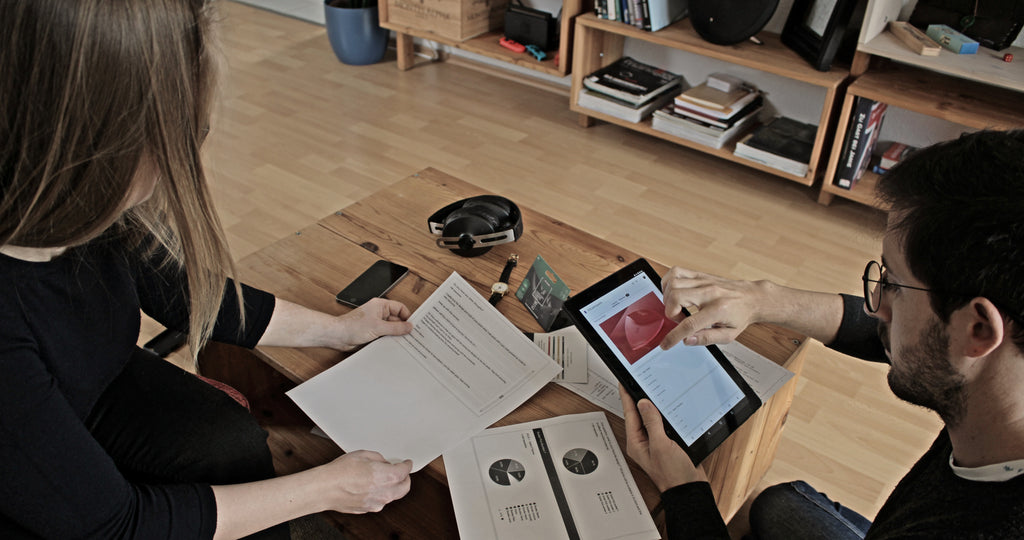
What is a signature guitar pick:
Signature guitar picks are common in the guitar pick world.
These picks were developed with the help of some expert and famous guitarists from a specific music field.
From our point of view, this is a very narrow design path that only considers the opinion and guitar playing style of one person.
Our approach: The opposite of a signature pick:
The guitar community has strongly supported Rombopicks since its beginning in 2019.
We did not want to create new guitar picks without asking the people who have been with us since the beginning. You guys and girls are the core of Rombo, and you should decide which products we develop.
The most logical step was to create a big survey to allow users to tell us how they prefer their guitar picks.
We think this is the only way to develop our guitar picks, based on the wants of our users, allowing us to make essential decisions about our company's direction.

This is only possible by listening to the thoughts of every guitar player.
In addition, by asking precise questions about guitar picks, we are able to create more awareness of complex issues, like: Why are guitar picks thick or thin? How they behave when the size changes? Does the flexibility of a guitar pick affect the tone? What about the material?
When the user is aware of the product features, he/she can deliver a useful vote.
Since the beginning, we have been researching all these areas and are sharing them with you. With every article about plectrums we have written, we have contributed to the knowledge you have about your gear so you will be able to decide which gear is the best for you and understand why.
The results of the survey:
Participants:
1.552 guitar players (including us) have participated in the survey and therefore have took part in the design process of these new guitar picks for 2021.
336 of them left a private message with detailed information.

What is your favorite guitar pick design?
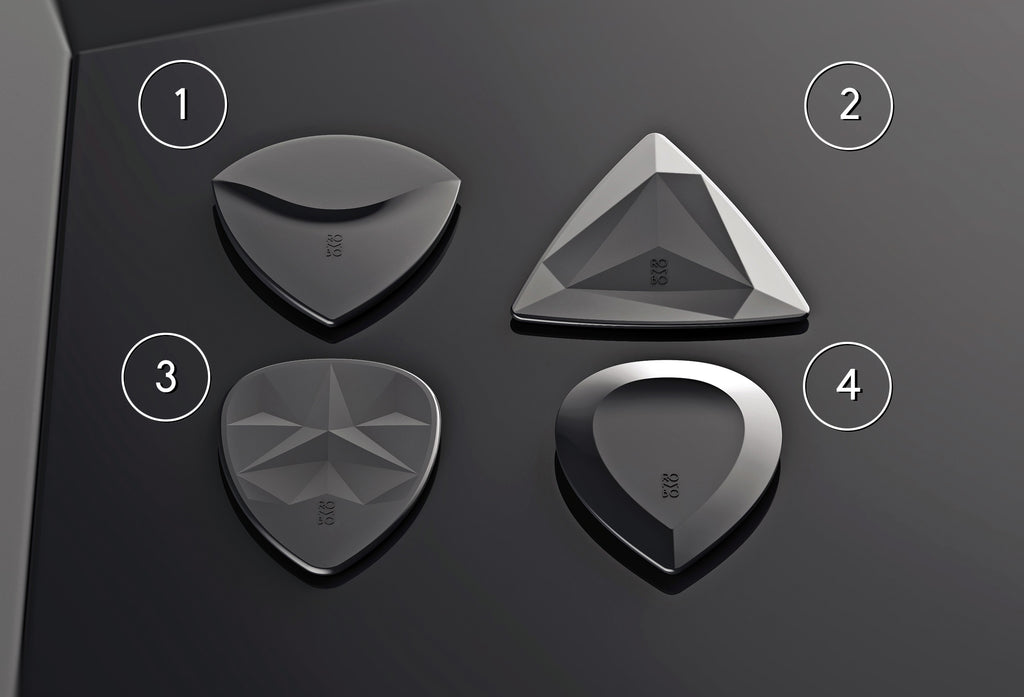
Pick number1: 18,8%
Pick number 2: 14,8%
Pick number 3: 27,8%
Pick number 4: 38,7%
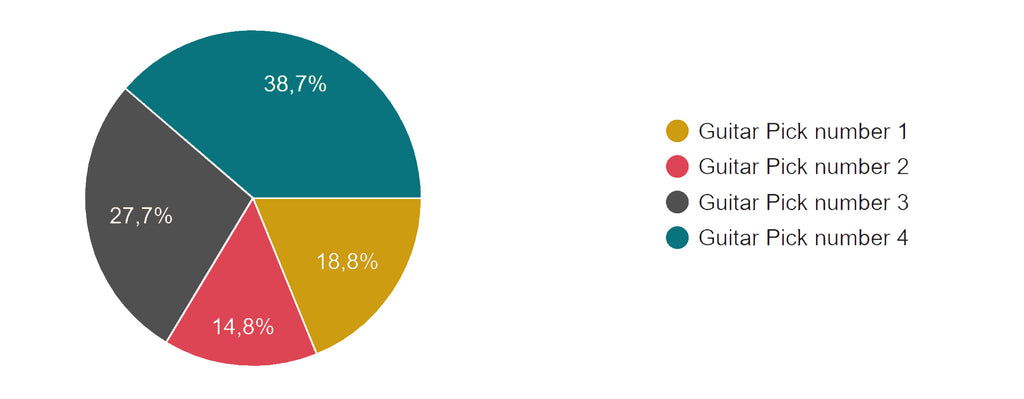
Guitar Pick Number 1:

Name:
Rombo Horizon: 34,5%
Rombo Sense. 33,9%
Rombo Summit: 14,1%
Rombo Mood: 7%
Other names: 10,5%
Average Thickness: 1,378 mm
Average Size: Medium Size with 71% of the votes
Guitar Pick Number 2:

Name:
Rombo Prisma: 76%
Rombo Spin: 7,7%
Rombo Treble: 8,4%
Other names: 7,9%
Average Thickness: 0,831 mm
Average Size: Large Size with 73,5% of the votes
Guitar Pick Number 3:

Name:
Rombo Crisp: 47%
Rombo Split: 22,1%
Rombo Prisma: 16,4%
Other names: 14,5%
Average Thickness: 1,028 mm
Average Size: Medium Size with 59,7% of the votes
Guitar Pick Number 4:

Name:
Rombo Jade: 33%
Rombo Shift: 17,6%
Rombo Slope: 12%
Rombo Summit: 10%
Rombo Dune: 7%
Rombo Cascade: 7%
Rombo Wizzard: 4,9%
Other names: 8,5%
Average Thickness: 2,37 mm
Average Size: Small Size with 56,6% of the votes
Guitar picks: Personal thoughts of 336 guitar players

A total of 336 people left us a private message regarding guitar picks.
We have read all of them carefully and we will use all this information during the development.
Here are the important questions we have received and our comments to them:
-
Will the guitar picks be available in new colors?
Not at the moment. However, we are thinking about creating some additional colors for special editions in the future.
-
Will they have the same grip structure?
Yes! Definitely. Lots of people have sent us e-mails and letters regarding the grip structure. With the micro-nodules, we have the advantage of medium-grip surfaces which add lots of control.
However, a very small number of people want the picks to have more grip. We had to make a decision here, and it was hard.
We won’t forget this topic: In the future, we want to develop a texture with more grip for these players.
-
Why don’t you create different guitar pick thicknesses for each one of the models?
We want every guitar pick to be unique. As every person has unique preferences, we believe every guitar pick should have its own design.
In the future, we hope to be able to create a bigger quantity of different plectrum designs to cover each possible necessity.
-
What about picks for bass players?
Most our picks are compatible with bass, as we have confirmed this with some bassists that are using them regularly, especially Rombo Diamond ad Rombo Origami. We explained this HERE.
-
You should create some merch, T-Shirts and other stuff:
Maybe in the future. Now, we want to focus 100% on the development of the guitar picks. Every minute we spend on the design of a T-Shirt will be taken away from the quality of the picks! ;)
-
Will you offer the EcoBlack range in other colors?
The EcoBlack material can only be produced in one color at the moment. The recycling process creates a very dark pigmentation. The industry is working hard to find a way to create new recycling processes. We hope we will manufacture all of our picks out of recycled material in the future.
When will be the new picks available?

The new guitar picks will be available in early 2021.
If you want to receive an E-Mail as soon as the picks are availabe, join our mailing list below on the footer.
This is the timeline we created for this project:
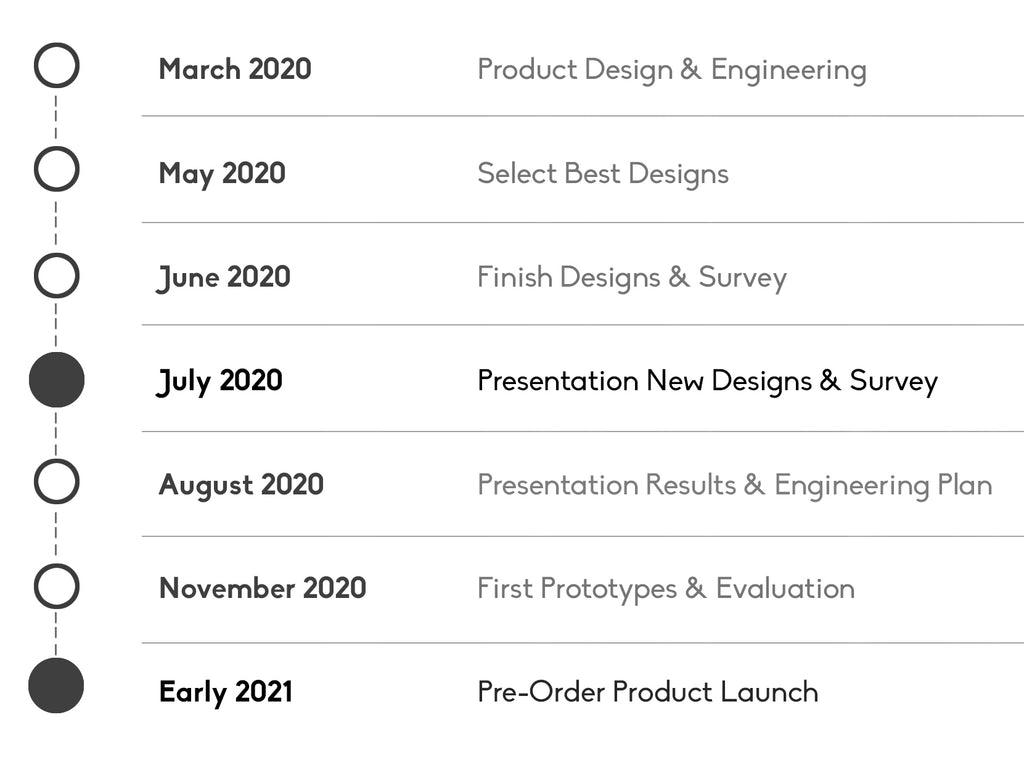
The pre-order product launch will be on the platform Kickstarter (like the first generation of Rombo guitar picks we launched in January 2019).
However, the current development of the Covid-19 could postpone the project a couple of months. We want to launch the product when we are able to deliver worldwide.
Why Kickstarter?
Kickstarter campaigns turn dreams and ideas into reality. Rombo is still a small start-up run by two people, and with limited access to resources. Through Kickstarter, we involve the community of guitar players, showing our guitar picks before launching.
This process brings us in contact with the real guitar players and their necessities. It forces us to remain flexible, accept changes, and challenges us to create new designs to fulfill the expectations of our audience.
We love open and critical criticism, and this is the best place to get it, where all comments and thoughts are visible. By sharing your experiences, we can listen to your needs and wishes, and create guitar picks that make a difference.

Guitar Pick for Beginners
Guitar picks are one of the most useful accessories for beginners, who have just started to play the guitar or bass.
Having a guitar pick won’t make you a professional guitar player faster, but will enhance the playability of your guitar.
With the right plectrums, you can easily learn new techniques and shape your skills.

The amount of guitar pick brands available on the market today is huge. This can be overwhelming if you are a beginner guitarist, and choosing the right guitar pick can be a tough process if you start in the wrong place.
But first of all: Who is considered a beginner guitar player?
Who is Considered A Beginner Guitar Player?
A beginner guitar player could be someone who just started playing last week, or, someone who has been practicing guitar for 2 months.
It is very difficult to define a line between the beginner and intermediate stages of guitar playing. Especially when you have learned to play the guitar yourself.

In general, to be considered an intermediate player, you should know and master the following areas:
- Change smoothly between fundamental open chords.
- Know power chords and be able to move around then cleanly.
- Know the difference between major and minor basic chord shapes and sounds by hearing.
- Know the note positions on the fretboard for the low E and A strings.
- Having mastered a significant amount of strumming patterns.
- You are able to practice using a metronome, and are aware of your comfort tempo for every technique.
- Have a basic understanding of music theory for musical keys and chords.
- Play through several complete songs smoothly.
- You’ll need to feel familiar with the basic lead techniques of picking, bending, and sliding,...
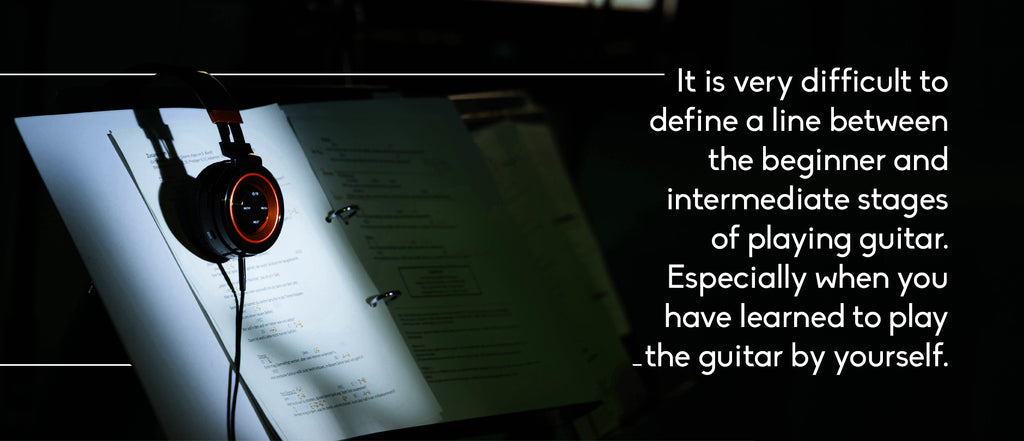
Why Use Guitar Picks?
Guitar Picks have different advantages when comparing them with fingers.
Guitar picks help increase your playing speed, produce a louder, brighter sound than fingers, and can be shaped to achieve better results when using different techniques like strumming or palm mute.
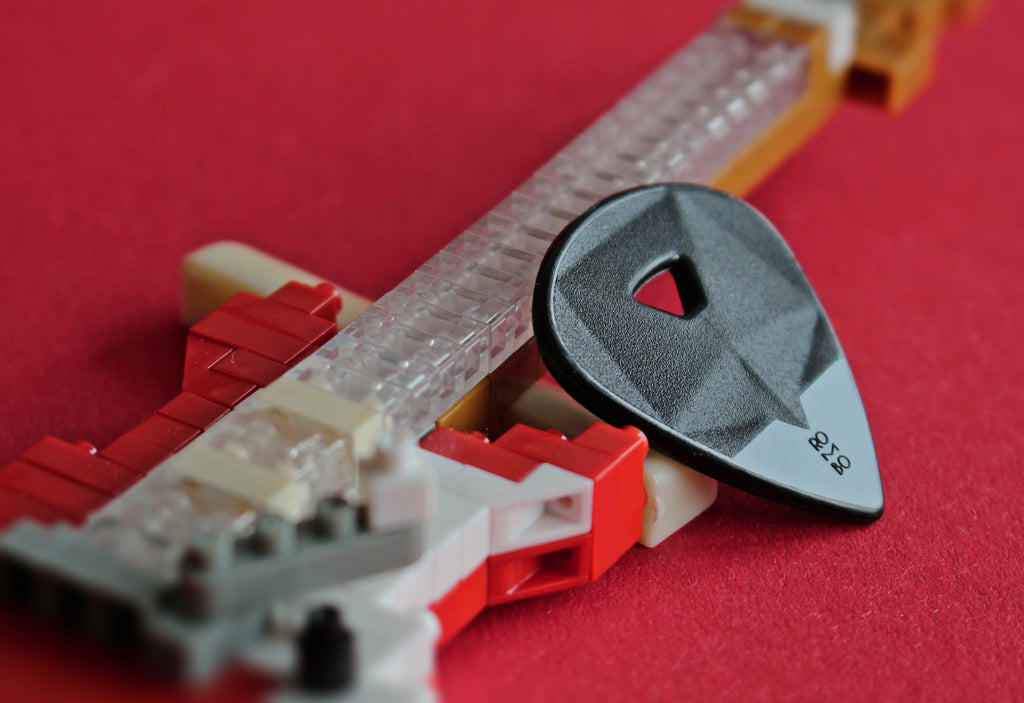
In general, plectrum techniques are easier to master than classical fingerstyle, or hybrid. It is easier to play fast picked notes.
As a beginner, this is very motivating, since your process of learning will be accelerated.
Guitar Picks - Quick Guide:
At the very beginning of your guitar learning process, your feeling of sound and feedback provided by a guitar pick as not yet developed.
Therefore, you should consider only these two attributes of a guitar pick:
- Guitar Pick Thickness
- Guitar Pick Shape.
Simplifying the “science” of a guitar pick will help you make a fast choice without spending too much time and stress.
After your first couple of months playing guitar, you will develop new skills, which will allow you to introduce more complex factors to your final decision of which pick to buy, guitar pick material, guitar pick size, and other special features.
If you feel secure enough to understand these additional features of a plectrum, go to our guide: How to choose the right guitar pick, which you can find HERE.
For the thickness and the shape, here is where you should begin:
0,75 mm Guitar Picks: The Best Choice for Beginner Guitar Players
Light guitar picks with less than 0,6 mm are considered beginners’ guitar picks.
The reason for this, is that most beginner guitar players first learn strumming techniques, which can usually be played better with thinner plectrums.
However, medium guitar picks with 0,75 mm thickness are the best place to start.

Plectrums with medium thickness are the most versatile in terms of tone, and can be used for rhythm and lead guitar.
If you are having fun with strumming exercises, medium thickness will perform well. If you need to practice some lead guitar techniques, it will work as well.
Depending on the kind of guitarist you want to become, you may consider moving to a higher or lower thickness range afterward.
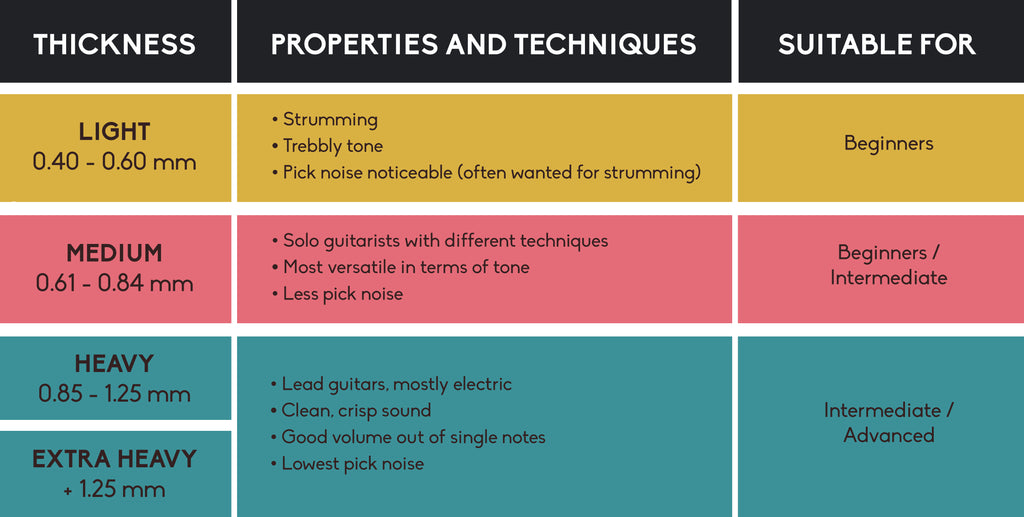
Rombo Origami is a good example of a medium thickness guitar pick.

Teardrop Shape and Standard Shape Guitar Picks: The Best Choice for Beginner Guitar Players
Teardrop shape and standard shape guitar picks are simply the most common shapes for plectrums, and globally famous by every single guitar player.
You cannot go wrong if you use one of these shapes for your first guitar pick.
Both picks have enough surface for a solid grip, and the tip has mostly a medium radius, and often even a light bevel edge for smoother playing.
When is it time to change the guitar pick?
I am not talking about wear and tear. For this, we already published the article “Guitar Pick Durability”
What I really mean is, when is it time to question the guitar pick model you are using and use a different thickness or a different material?
Avoid sticking with a single guitar pick model for the rest of your life.
Using different guitar picks will give you the possibility to increase your tonality ranges, develop a more accurate feeling for different guitar techniques, and be more aware of your preferences when it comes to guitar gear.
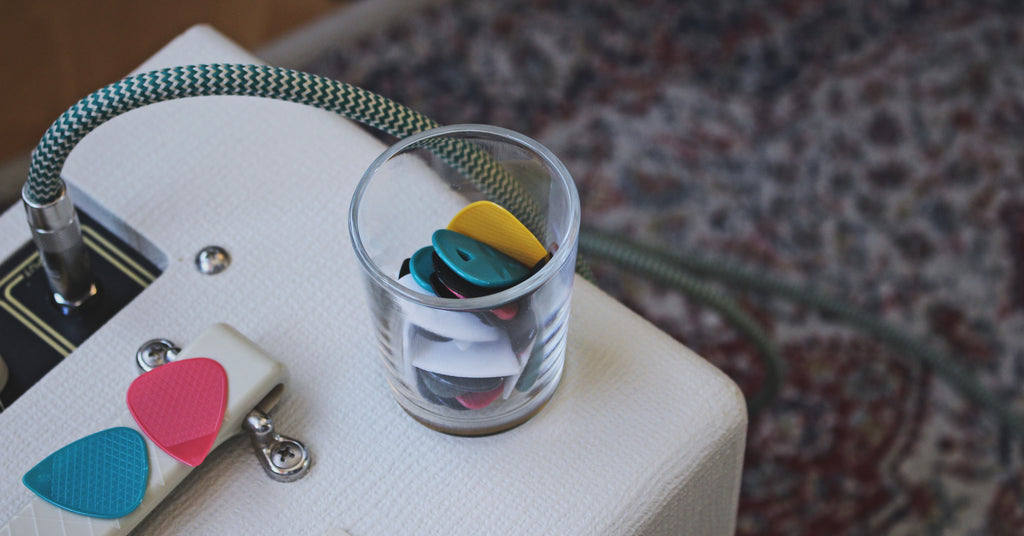
Therefore, the answer is: always! I cannot recommend enough, the benefit of testing as many different plectrums as possible, and then decide which ones are your favorites.
I used the plural noun “favorites”, because you should find at least 3 of your top guitar picks.

As you develop your skills as a guitarist, you will notice that some guitar pick shapes, or guitar pick thicknesses, are more adequate for specific techniques.
Discover our variety pack HERE
In my case, I like medium picks for strumming, hard ponty guitar picks for practicing scales and loud music, and very rounded guitar picks for the days I just want to relax, use my reverb pedal, and create beautiful clean guitar melodies.
Conclusion: The Right Guitar Pick For Beginners
An important part of learning guitar, is knowing the gear you use: The amplifiers, the pickups, the different guitar strings, the guitar pedals, and also the guitar picks.
Don’t feel overwhelmed by the amount of guitar picks out there. It’s just a matter of preference, and you will have to spend some time trying new guitar picks, which can be fun and bring you some nice experiences.
You can start with a standard shaped guitar pick with 0,75 mm thickness. But, if you don’t feel comfortable with just one option, try a variety pack, containing some different guitar picks. Close your eyes, and chose the guitar pick that feels right to you.
Please leave a comment and tell us the thickness of the first guitar pick you had. Thanks!

Guitar Pick Durability: Everything You Need To Know
The guitar pick has been in constant evolution since the 1920s.
Today, 100 years later, we have achieved great accomplishments in the area of durability of this very important piece of guitar gear.
In this article, we will review all the important points that can cause picks to wear out, and summarize all you need to know about guitar pick durability.
We will make some comments on the tone, to help control the changes, which happen after a guitar pick has worn down.
In addition, we will give some advice to keep your picks “healthier“, longer than expected.
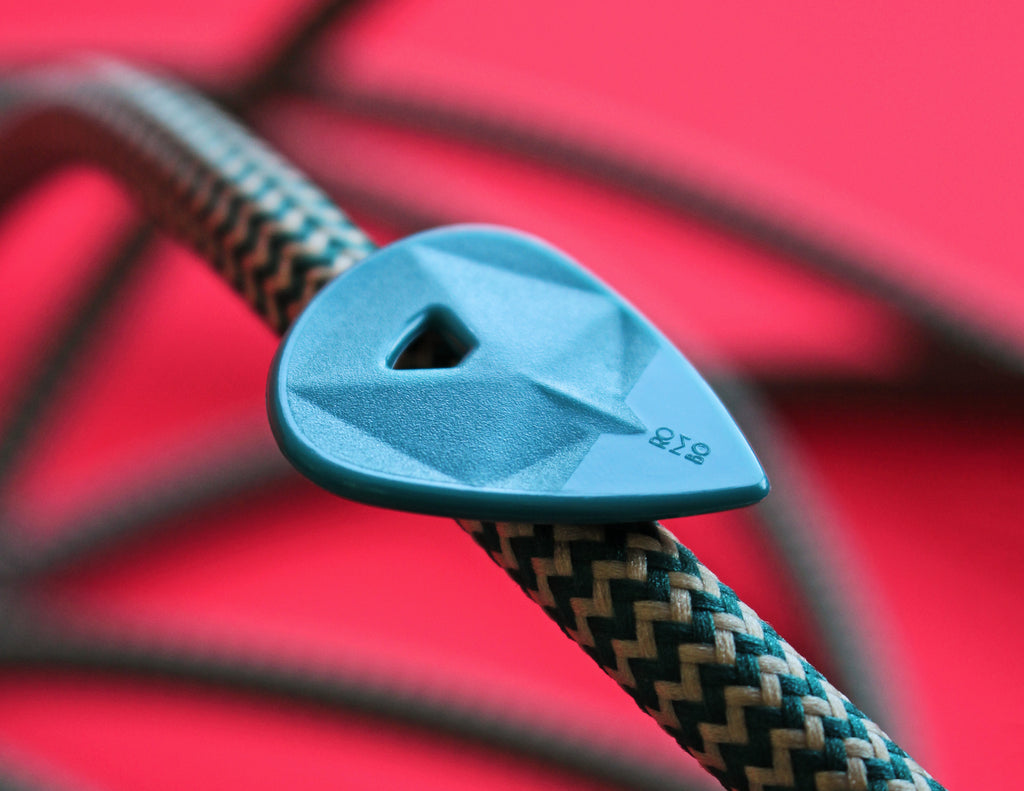
New vs. Old (worn down) Guitar Picks: Tone Changes
We all know that using different guitar picks, will also make a difference in your tone, and your playing. Material, shape, thickness and shape of the pick, directly affect the tone and playability.
Most standard plectrums can resist heavy strumming for a long time, without much wear and tear.
The first thing you may notice after using a guitar pick for some weeks, is that the tip is not as pointy as the new guitar pick. You will see it, and you will hear it, because the tone of the pick will change over time, with wear.


The rounded shape of the worn down plectrum, will create warmer tones, and feel darker. This is totally fine, if this is the tone you are looking for.
It will also affect the way your plectrum plucks the strings:

Just like the guitar strings, the frets, & other components, the guitar picks will wear out over time.
Some players feel a lack of control after the guitar pick has worn down, while others use the rounder picks because of the tone they produce. This especially happens to jazz guitarists, who tend to choose picks that are almost circular, for example: Rombo Waves.
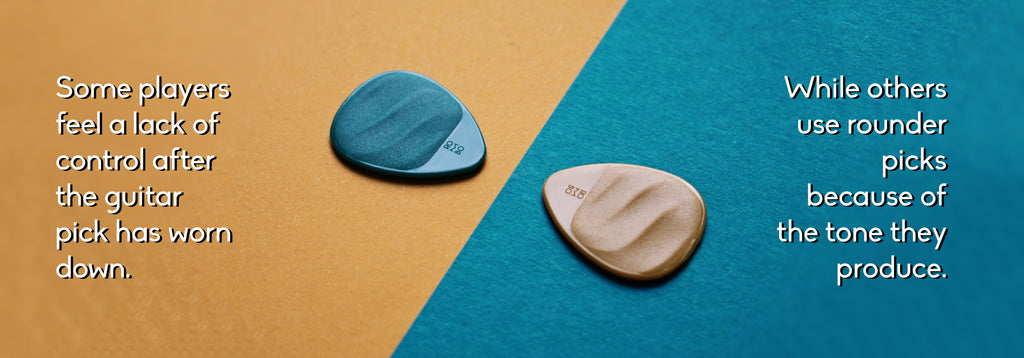
Gaining control when using rounder guitar picks, is an ability you can train yourself to do, and improve.
Why Can’t Picks Last Forever?
Guitar strings are usually made from a mix of steel, nickel, bronze, or brass. In other words: Metals.
Since most players use some kind of plastic material for their guitar picks, (nylon, delrin, …), it’s not surprising that friction between strings and picks will cause the guitar picks to wear down.
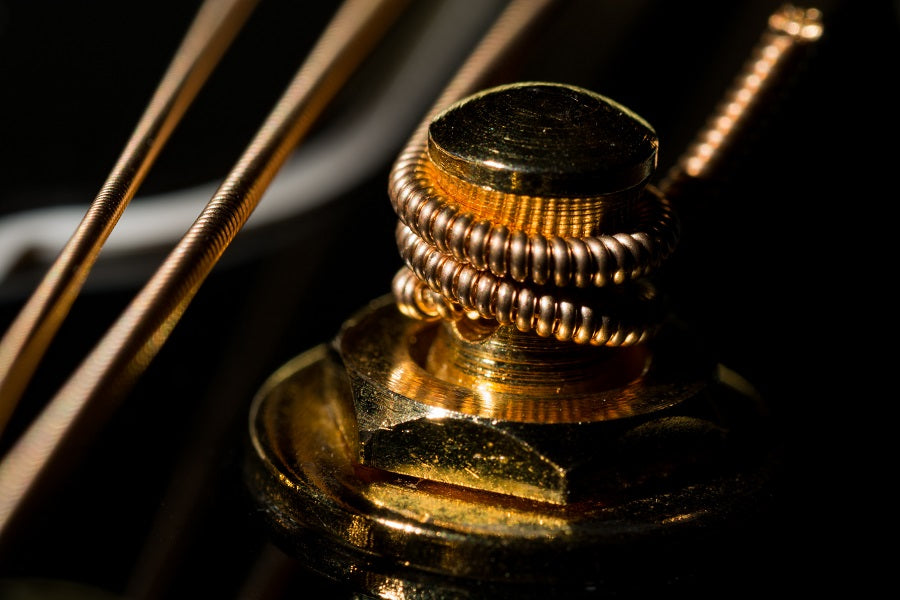
You will notice, the thickest guitar strings have a spiral wire wrapped-around, acting like a sanding file on the plectrum.
Guitar Pick Durability: How Long Should a Guitar Pick Last?
The short answer: If you are an average user, your picks should last a few weeks to a month. If you are a professional player, using specific techniques, like heavy picking and strumming, it will probably last just one day, especially if you are a studio musician recording new tracks every day.
The long answer: This answer includes many factors including guitar pick attributes, and external factors, regardless of the guitar pick you are using. We discuss all of them below.
Guitar Pick Attributes That Directly Affect the Durability
The attributes that define the durability of a guitar pick are as follows:
- Guitar Pick Material
- Guitar Pick Thickness
- Guitar Pick Tip Shape
- Guitar Pick Tip Texture
Harder materials will wear down slower. This is one of the reasons there has been a lot of research in the area of suitable materials for guitar picks.
The goal is to find a wear-resistant material, that keeps the tone characteristics that guitar players want, while still giving a good grip.
However, material is not all. The thickness of a guitar pick will enormously affect the wear and tear. Thinner picks will wear down almost immediately when using heavy pick techniques.

Other attributes of the pick that affect the durability, are the Tip Shape, and the Tip Texture. Very pointed guitar tips tend to wear down faster, because there is less material on the tip.
However, this problem can be partially solved with the right guitar pick tip texture. A polished tip on the guitar pick will cause less friction between strings and plectrum. This is one of the most underrated attributes of a guitar pick, and you can find more information HERE.
What Damages the Pick the Most?
Results show, that the best way of altering and degrading the shape of your plectrums is to perform “pick slides”.
This guitar technique will wear away the edges of your plectrum and will make it useless very quickly.
This won’t directly affect the tone or control of the plectrum, but the damaged sides will contain some dents. The plectrum will get stuck either on the up stroke or the down stroke.
External Factors Which Indirectly Affect the Durability
It’s not only the guitar pick quality that is responsible for its‘ damage. There are three more factors that can play a role on the durability:
- Hours of guitar training
- Guitar strings gauge
- Guitar playing style and used techniques
It is a very simple equation: The more hours you practice, the more your picks will get damaged.
Thicker guitar strings will increase the area of contact with your plectrum, and therefore, wear it down much faster.
Aggressive guitar playing techniques, like fast palm mute, or pick slides, will damage your guitar pick very easily.
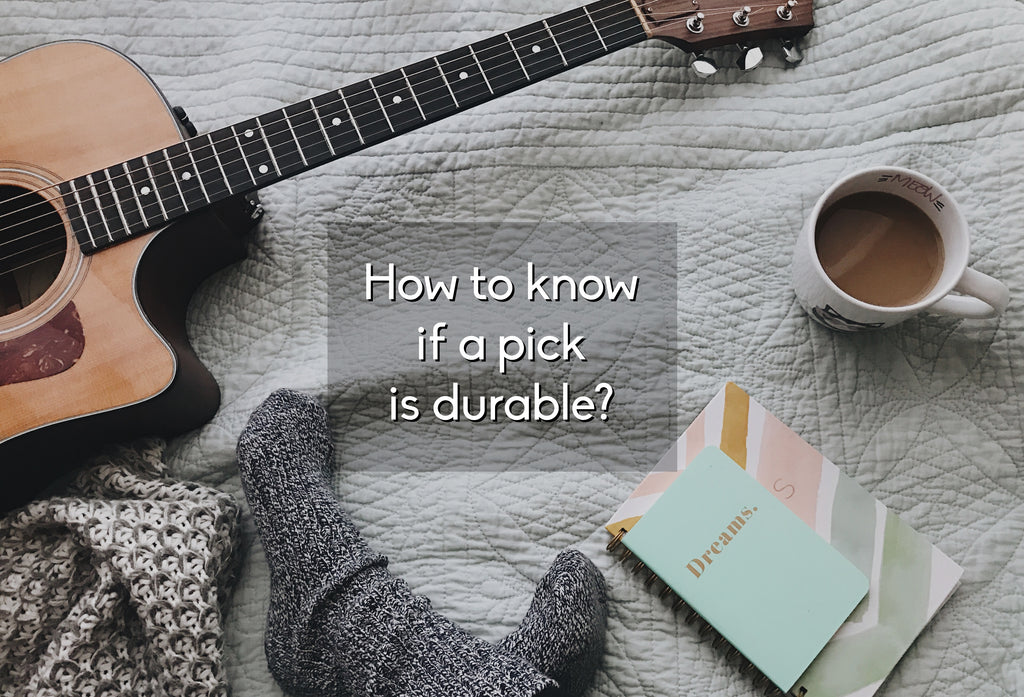
How to know if a Pick is Durable?
The best way to find out, is to test it, and make your own judgment.
You can take advice of expert players, who have tested lots of guitar picks. However, if their playing styles differ from yours, this information won’t help much.
Besides, many expert players have not changed their picks for decades, and they might be missing the material improvements of the last decade.
As mentioned, not only is durability a factor to take into account when choosing a guitar pick, but also the tone and the ergonomics (grip, size,...).
How to Know When to Replace Your Pick?
If the edges of your pick are becoming more rounded, you might start to consider purchasing a new one.
However, never throw away your worn-down guitar picks! The rounded edges can be used to create more mellow tones, and you might want these for some of your songs.
One of the most important things about playing the guitar, is to keep your mind open to new tones and styles. This is the reason some guitar picks have rounded tips even when they are new.

In addition, you can store your old guitar picks in a box. I wish I still had my first guitar pick, that I used, when I was learned to play guitar as a child. A guitar pick can be a beautiful piece of your past.
Check Your Pick Condition Regularly
A tip from my side, is to double check every guitar pick before going out on stage, or studio. A visual inspection is fine.
Always keep some unused plectrums aside. Considering plectrums are probably the least expensive gear of your complete guitar rig, constant wear and tear issues is not a thing you should worry about.

Choose your ideal Plectrum
Are you using the right pick? This is a question you should ask yourself every time you play a song.
Some players have their 5-favourites, depending on the style and type of guitar they want to play.
The most important factors when choosing the right plectrum for you hinges on….
- Material
- Shape
- Thickness
- Size
- Playing style
- Your personal preference
We created a guide that will help you find the right plectrum for you.
You can find it HERE.
Thank you!
The support we are getting from the guitar community makes us very happy!
We, (Carlos and Judith), are really doing our best to create the best guitar picks for you.
If you consider supporting a small family start-up, you can share this article and directly have an influence on our online visibility.
These small actions have helped us since January 2019, and we count on your support! :)

Thanks!

The Guitar Pick: Advantages of a Plectrum with Variable Thickness
For most people, the thickness is one of the most important attributes of a guitar pick.
The thickness of a plectrum defines how dark or bright the tone becomes. It has an enormous impact on the feedback you directly receive from the guitar strings, and the control you have over the pick.
What is a guitar pick with a variable thickness?
It is a plectrum, whose body and tip have different material thicknesses (see the figure below).

They combine both aspects of thin and thick picks: comfort, рrесіѕіоn, rhуthm, and ѕрееd of рlау. You gradually gаіn flexibility іn thе mоvеmеnt оf уоur hаnd to рrоduсе a mоrе fluid gаmе and the desired ѕоundѕ that you imagine are realized.
Avoiding “flat” guitar picks and using guitar picks with variable thickness will offer several advantages for your playing style.
5 advantages of using a guitar pick with variable thickness:
- The solid and thick body of the plectrum gives you a better grip and control.
- By increasing the material thickness, the designers can create deeper and more complex 3D surfaces in this area of the guitar pick.
- A thinner tip will give you enough flexibility to achieve greater versatility when developing different guitar techniques.
- Increased bass when using thinner pick tips: The thicker body will create a darker sound, while you can still enjoy high treble caused by the thin attack area.
- The contrasting vibrations on the different areas of the guitar pick will create a new ergonomic experience.

Conclusion:
Variable thickness is one of the most uncommon features of guitar picks. Using these types of guitar picks for the first time might cause your fingers to have a short adaption phase, during which they will relearn how the physics of these picks behave.
At the end of the process, you will learn how to control a new type of gear and take advantage of the five points mentioned before.
There are many other attributes that can help you take your playing skills to the next level: Discover more in my article, 6 Underrated Features of a Guitar Pick.
Folge uns
Judith Heindorf & Carlos Diez Macia GbR
Auf der Steige 29
71686 Remseck am Neckar
DEUTSCHLAND
- Shop
- Händler
- Impressum
- AGB
- Widerrufsrecht
- Versandbedingungen
- Datenschutzerklärung
- Kontakt
- Presse
- Fragen & Antworten
Melde dich zu unserem Newsletter an und erhalte alle Neuigkeiten zu Sales, Neuerscheinungen und vielem mehr…
Mit der Anmeldung stimmst du unseren Datenschutzbedingungen zu.
© 2025 ROMBO.
ist eine registrierte EU-Marke.
Wir nutzen Shopify.


